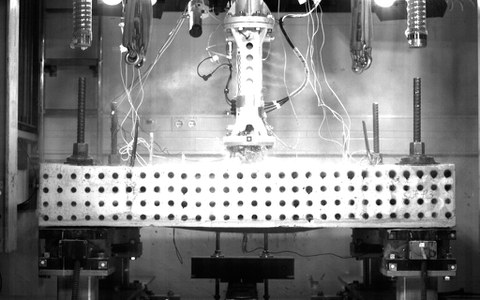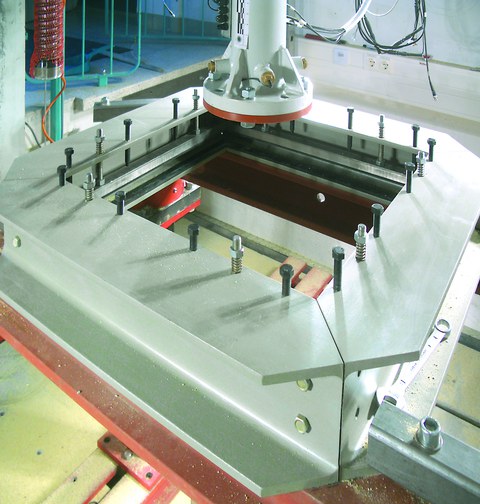TRC slabs under impact
Table of contents
Projektdaten
|
Titel | Title |
Report in the annual report 2018
TEXTILE REINFORCED CONCRETE AS ADDITIONAL SAFETY

Reinforced concrete slab strengthened with carbon reinforced concrete during the experiment
In the current research project, the effect of thin textile reinforced concrete layers applied on the not impacted side of flat or wall-like structures is being investigated. These considerations include a wide range of different reinforcement types that are be used as reinforcement in the strengthening layer. With regard to the use of textile reinforced and carbon reinforced concrete, special attention was paid to the investigation of different glass, basalt and carbon reinforcement fabrics.
For the systematic investigation of the different meshes in a fine concrete matrix, a new test concept was developed, which enabled a fast and cost-effective test execution. Based on the results from these tests, a new reinforcing textile was developed in cooperation with the Institute of Textile Machinery and High Performance Materials (ITM), whose properties were optimized with regard to impact resistance. After its fabrication, the new reinforcing fabrics first had to prove their efficiency. On the one hand, this meant that it could be easily applied as a reinforcing layer and, on the other hand, it had significantly improved properties which in turn resulted on an improved reinforcing effect when subjected to impact load.

Unterseite einer verstärkten Stahlbetonplatte nach dem Versuch
For this purpose, reinforced concrete plates of various thicknesses were produced and subsequently strengthened with a layer of textile reinforced concrete. The manufacture of the concrete plates was carried out on the same day for each plate thickness, with a single batch of concrete to ensure a direct comparison of the strengthening layers. The same procedure was followed when applying the strengthening layer. This ensured that the test specimens only differ in the reinforcing fabric used.
The investigation of the strengthened reinforced concrete plates finally took place at the drop tower of the Otto Mohr Laboratory (OML). The test specimens were subjected to the identical loads. In the experiment, both reinforcement fabrics showed a good strengthening effect. The on-going investigations at the OML will show whether the protective effect could be further increased with the newly developed fabric.
Report in the year book 2017
PENETRATING EXPERIMENTS WITH TRC

Rear side of a tested plate made of carbon reinforced (4 layers of strengthening fabric) concrete after impact testing with a impactor energy of 4500 Joule; the impactor has stopped inside the plate
The AiF Project aims to use textile reinforced concrete (TRC) for the strengthening of structural elements exposed to extraordinary load cases. Until now, TRC has been mainly used for static strengthening tasks. The extraordinary load case for which we want to use textile reinforced concrete is a scenario in which a structure is subjected to a sudden impact load.
To investigate the strengthening efficiency of textile reinforced concrete, many impact experiments were conducted at the Otto Mohr Laboratory. For these experiments, the accelerated drop tower facility was used. The tested specimens were provided with a defined amount of strengthening material or strengthening textiles. In the experiments, different textiles made of carbon were used. Furthermore, the number of textile layers, the yarn’s fineness and therefore the yarn’s strength, as well as the mesh size of the fabrics were varied. The concrete matrix which was used to embed the textile fabric remains the same for all tests. The experiments were performed in a special designed experimental setup which allowed a systematically experimental investigation of the different parameter combinations. Based on the acquired knowledge, the development of new strengthening materials, or textiles, which can efficiently resist impact loads, will be advanced.
An essential part of the development of such strengthening structures is both the basic knowledge about the material and its structural behaviour. Especially, the interaction between concrete matrix and textile is a deciding factor for the efficiency of the strengthening materials to be developed. In 2017, the research focus was on the investigation of existing strengthening materials. In 2018, the research focus shall be the investigation of large size reinforced concrete plates which were strengthened witch TRC layers. These tests are important to validate the knowledge from the small-sized specimen. Taking into account the small and large scale tests, it shall be possible to infer the behaviour of the reinforced structure. To manage this complex task and to develop new strengthening textiles, the project is done in cooperation with the in Institute of Textile Machinery and High-Performance Material Technology of TU Dresden.
Report in the year book 2016
Textile reinforced concrete designed for worst cases

Impact test set-up with clamping device for TRC plates
Textile reinforced concrete has been used in the past for static or quasi-static load cases only. The main aspect of this project is to expand the range of applications of textile reinforced concrete by demonstrating its suitability for structures that may be exposed to short-term dynamic loads. To do these a wide range of examination is necessary. The project goal includes the development of a textile reinforcement which is designed for impact loads. These textile impact reinforcements shall be embedded in a concrete matrix. In this way, a maximum impact resistance should be achieved. The textile development includes 2D and 3D textile structures. To investigate their behavior and relevant properties under impact loads, drop tower experiments with plates made of textile reinforced concrete are proposed. The interaction between textile reinforcement and concrete matrix are the focus of these drop tower experiments.
Because of the high complexity of the short-term dynamic load case and the development of a completely new textile reinforcement structure, cooperation with our project partner, the Institute of Textile Machinery and High Performance Material Technology, is necessary. The success of the project depends on the good cooperation of both institutes.
The first stage of the project contains the investigation of textile reinforcement structures which are most suitable for impact testing. After that, textile reinforced concrete structures shall be designed for impact loads using the knowledge that will be gathered from this experimental program. In this way, light-weight and impact-resistant structures, able to resist impact loads, will be developed as an alternative to the heavy structures, which are currently used. The long term effect of this project involves the resource-efficient design of structures which can withstand impact loads.
